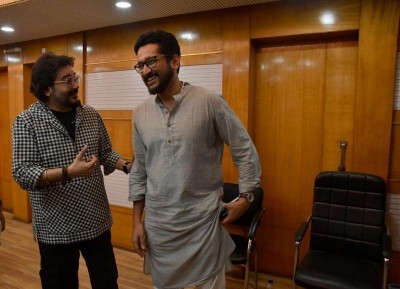Cinema will never die: Govind Nihalani at KIFF
"It has the power to project the filmmaker's point of view he places through visuals and audio in his own way," he said.
"Cinema is a living organism of our time. It evolves with time, with history and with the shape of things to come. We evolve too with time and cinema is a part of our lives so it must needs make an impact on our lives," he said speaking at Nandan I, the main venue of the film festival.
Nihalani's films have archival value because they are shocking, violent and intense. He does not use these to shock his viewers but he structures them within the story and the script. His characters, both male and female, good or bad, are very strong, very honest and serious about their convictions about a particular issue or subject.
The main message of his address, delivered ex tempo, was that cinema will never die.
All of Nihalani's films from Aakrosh to Dev are character-driven and not intrinsically story-driven. The films are studies of how characters' beliefs, interactions with other characters, their work life etc, placed within a specific time and space backdrop lead to incidents and events that change their lives in some way or another.
He went on to explain that the power of cinema was so great that it could easily manipulate a filmmaker without his being aware that he is being manipulated by the very ingredients of his form of expression.
This power of cinema must be used with care and with discretion. There are 20,000 different ways of creating a film through the sound film image. "Technology is moving so fast that it is gradually becoming wearable. Some day in the not-so-far future, you might be able to watch a film on the back of your hand, who knows?" he asked.
"Cinema is never going to die because the possibilities it has of creating magic and the purest form of poetry will increase everyday. It can also create change. When you look at the potential of technology and the genius of man to use that technology to create images that can manipulate the minds of his audience is infinite and will remain so till eternity.
"Cinema also creates experience. It engages you because it gives you pleasure - visual, aural and emotional. It excites your senses and your emotions. It is an all-engaging and all-engulfing experience that engages our mind," he said.
He added that a viewer might or might not agree with the filmmaker's message of argument. But he will be moved in some way or another.
He said it is for the filmmaker to use the technology and the art at his disposal in a way which entertains you and if the filmmaker can do his job ideally with the art and craft of cinema, at the end of the film, the audience might sympathize with what he has tried to say through his film.
"You might feel that what he is saying is right or wrong, but if he can bring you to his side or his way of thinking, he has made a good film," he elaborated.
According to Nihalani, the cinematographic image is one where the shot, the angle, the size of the image and the lighting chosen is composed with a definite purpose, everything is calculated and designed.
"But there is an image that reaches beyond the physical reality of the cinematographic image. It goes beyond information and acquires a larger meaning than the information contained within a shot. These images carry and echo a lot of our subconscious memories, personal and collective, and grow into symbols," he said.
In response to a question on the relevance of Satyajit Ray in present times he said, "the relevance of the work of any filmmaker lies in his ability to connect with his viewers."
"For a filmmaker like Ray, this connect remains undisturbed across time and space and language.His film also reflects his environment, his time, his history and his future because cinema can also anticipate time. People sometimes label a film as a 'path-breaking' film. What does this word 'pathbreaking' mean? It simply means that the filmmaker has been able to reach beyond engagement and entertainment."
(Reporting by Shoma A. Chatterji)
Support Our Journalism
We cannot do without you.. your contribution supports unbiased journalism
IBNS is not driven by any ism- not wokeism, not racism, not skewed secularism, not hyper right-wing or left liberal ideals, nor by any hardline religious beliefs or hyper nationalism. We want to serve you good old objective news, as they are. We do not judge or preach. We let people decide for themselves. We only try to present factual and well-sourced news.





